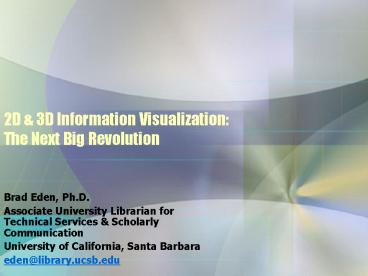2D PowerPoint PPT Presentation
1 / 22
Title: 2D
1
2D 3D Information VisualizationThe Next Big
Revolution
- Brad Eden, Ph.D.
- Associate University Librarian for Technical
Services Scholarly Communication - University of California, Santa Barbara
- eden_at_library.ucsb.edu
2
What is Information Visualization?
- The use of computer-supported, interactive,
visual representations of abstract data to
amplify cognition. - From Readings in Information Visualization
Using Vision to Think. Edited by S. Card, J.
Mackinlay, and B. Shneiderman. San Francisco
Morgan Kaufmann, 1999. p. 6
3
Other definitions from the literature
- The process of analyzing and transforming
nonspatial data into an effective visual form - A highly efficient way for the mind to directly
perceive data and discover knowledge and insight
from it - The visual appearance of data objects and their
relationships - The transformation of abstract data to a visual
representation, which is rapidly understood by
the user
4
Why is it important?
- Human beings are tremendously influenced by
sensory perceptions - The way that we learn, grow, understand, and
adapt is based on our ability to view, perceive,
and conceptualize thoughts and ideas - The power to visualize and graphically represent
results, ideas, solutions, and problems in
multiple dimensions, as well as to manipulate
data and virtually collaborate with others, is
the next big revolution in technology.
5
- Tell me and Ill forget
- Show me and I may remember
- Involve me and Ill understand.
- Ancient Chinese proverb
6
Who is doing it right now?
- Your users everyday
- Students
- Virtual collaborative gaming
- Collaborative spaces on the Internet
- On their Gameboys and home entertainment systems
- Faculty
- In the sciences (David Rumsey Map Collection at
http//www.davidrumsey.com/GIS/3d.htm) - In medicine (Visible Human Project at
http//www.nlm.nih.gov/research/visible/visible_hu
man.html) - In history (http//www.visionarywebsites.com/portf
olio_3d.htm2)
7
Areas of study already established in
visualization
- Data visualization
- Geographic visualization
- Scientific visualization
- Software visualization
8
Dimensional types of information visualization
- Temporal
- One-dimensional (1D)
- Two-dimensional (2D)
- Three-dimensional (3D)
- Multi-dimensional (MultiD)
- Tree
- Network
- Workspace
- See Olive On-line Library of Information
Visualization Environments at http//www.otal.umd.
edu/Olive/
9
3D information visualization presentation
techniques
- Benediktine space
- Cityscapes
- Cluster maps
- Concept mapping
- Fish-eye views
- Graphs
- Landscapes
- Networks
- Perspective walls
- Rooms
- Spheres
- Topic maps
- Trees
10
Programming languages for 3D
- Virtual Reality Modeling Language
(VRML)/eXtensible 3D (X3D) - http//www.web3d.org/
- Scalable Vector Graphics (SVG)
- http//www.w3.org/TR/SVG/
- Many other ones, by gamers and techies
11
An Atlas of Cyberspaces
- http//www.cybergeography.org/atlas/atlas.html
- Provides examples of graphic representations of
cyberspaces like the Internet, the World Wide
Web, and other digital environments. Divided
into topics such as historical, geographical,
MUDS and virtual worlds, weather maps,
conceptual, surfmaps, website maps, artistic,
cables and satellites, topology, census, etc.
12
Resources
- The Geography of Cyberspaces Directory
- http//www.cybergeography.org/vis_infospaces.html
- Information Visualization website
- http//iv.homeunix.org/
13
OPACs experimenting with 2D/3D
- Lexington Public Library
- http//www.lexpublib.org/
- AquaBrowser
- Topic map
- Belmont Abbey College Library, North
Carolina http//www.dlib.org/dlib/june03/beagle/06
beagle.html - Antarctica Systems, Inc. (MapNet and VisualNet
softwares) - http//www.antarctica.net
14
Stanford Grokker
- http//www-sul.stanford.edu/about_sulair/special_p
rojects/stanford_grokker.html - Available only to Stanford faculty, students, and
staff - http//www.grokker.com/
15
Interesting websites to explore
- LivePlasma
- http//www.liveplasma.com
- CubicEye
- http//www.2ce.com/
- 3D Virtual Reality Worlds
- http//vw.indiana.edu
16
More interesting websites
- 3D Insects
- http//www.ento.vt.edu/sharov/3d/3dinsect.html
- Visualization website
- http//visualcomplexity.com/vc/
- For more information, see 3D Information
Visualization Techniques 2D and 3D Information
Visualization Resources, Applications, and Future
(Library Technology Report, Jan./Feb. 2005)
17
Innovative Projects in the Humanities
- Library Technology Report, July/August 2005
- 10 x 10 100 Words and Pictures That Define the
Time - http//www.tenbyten.org/10x10.html
- Theban Mapping Project
- http//www.thebanmappingproject.com/
- Virtual Vaudeville
- http//www.virtualvaudeville.com/
- The Lost Museum
- http//www.lostmuseum.cuny.edu/intro.html
18
Companies and software
- ActiveWorlds (6.95 per month)
- http//www.activeworlds.com/
- Grokker (free 30-day trial)
- http//www.groxis.com/service/grok
- VisualNet
- http//www.antarctica.net/products/visualnet.sht
ml - Pacific Northwest National Laboratory (PNNL)
- http//www.pnl.gov/infoviz/
- Galaxies, ThemeView, Starlight, OmniViz Pro,
and IN-SPIRE - Anacubis (free 10-day trial)
- http//www.anacubis.com
- Aquabrowser
- http//www.medialab.nl/
- Inxight
- http//www.inxight.com/about/
- SmartDiscovery, VizServer, Categorizer,
LinguistX, Star Tree, Summarizer, Table
Lens, and Thing Finder - Vivisimo
- http//vivisimo.com/
- http//clusty.com/
19
- See also Judy Luther and Maureen Kelly, and
Donald Beagle. Visualize This. Library
Journal. March 1, 2005, p. 34-37. - Bernard Frischer. The Ultimate Internet Café
Reflections of a Practicing Digital Humanist
about Designing a Future for the Research Library
in the Digital Age. Library As Place
Rethinking Roles, Rethinking Space. CLIR,
February 2005, p. 41-81. - http//www.clir.org/pubs/reports/pub129/pub129.pdf
- Bernard Frischer. From CVR to CVRO The Past,
Present, and Future of Cultural Virtual Reality. - http//www.cvrlab.org/research/images/CVR20to20C
VRO.pdf
20
- From CVR to CVRO
- If the ten-year rule of thumb holds true,
personal computer enthusiasts by the millions a
decade from now will be interacting directly with
virtual worlds through their desktop reality
engines. - Howard Rheingold (1991)
21
- Also from CVR to CVRO
- All men by nature desire to know. An
indication of this is the delight we take in our
senses for even apart from their usefulness they
are loved for themselves and above all others
the sense of sight. For not only with a view to
action, but even when we are not going to do
anything, we prefer seeing (one might say) to
everything else. The reason is that this, most
of all the senses, makes us know and brings to
light many differences between things. - Aristotle, Metaphysics 980a (ca. 330 B.C.)
22
- Questions?
- eden_at_library.ucsb.edu

